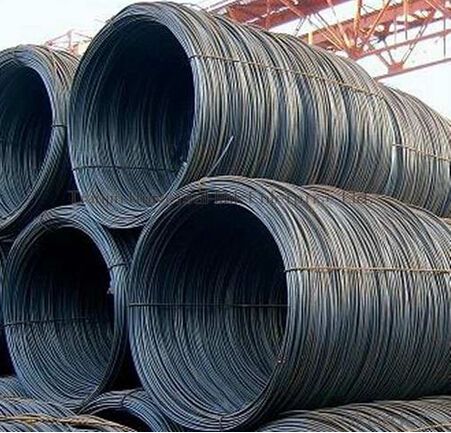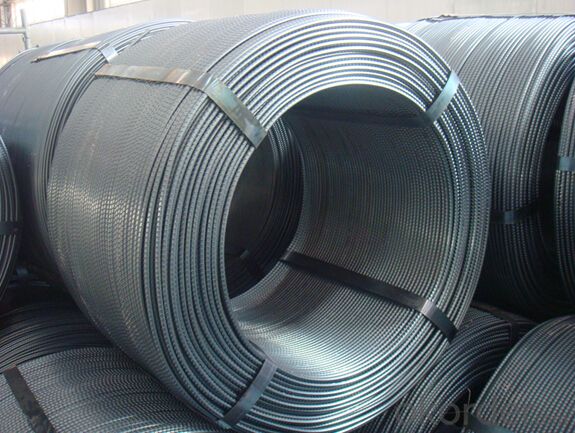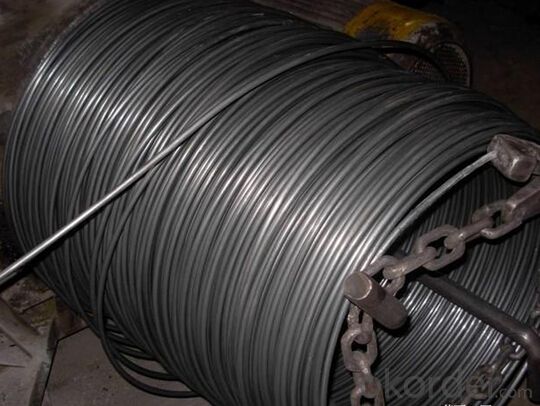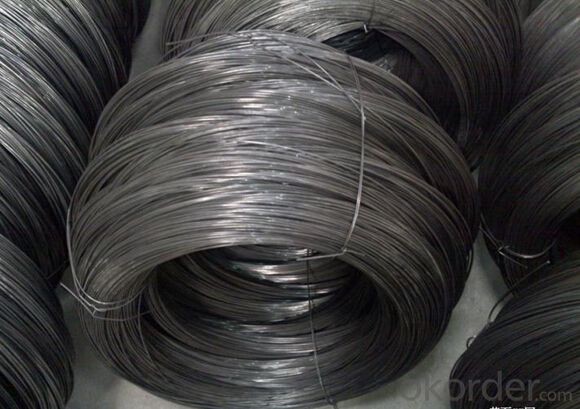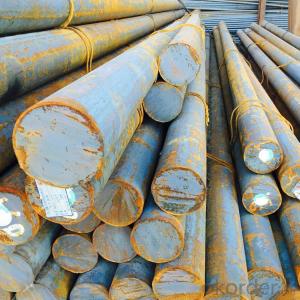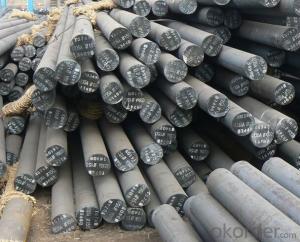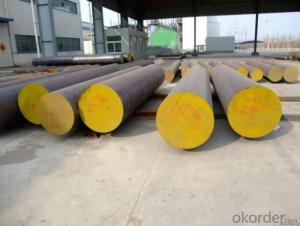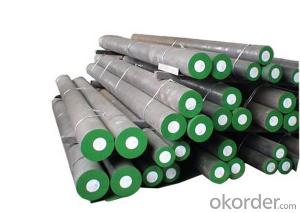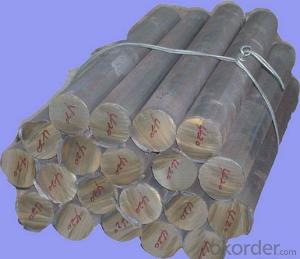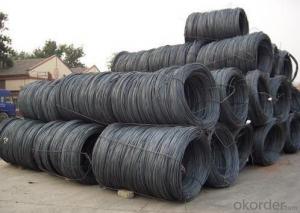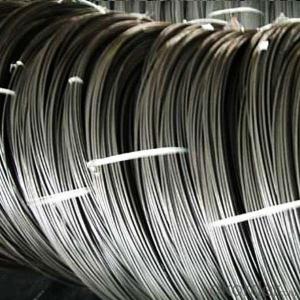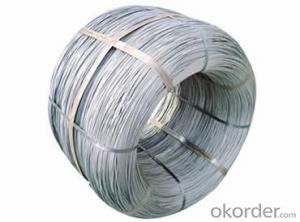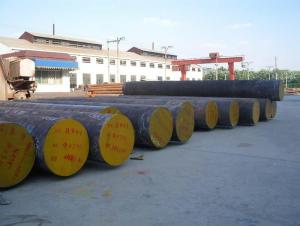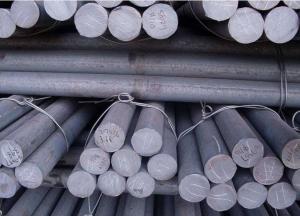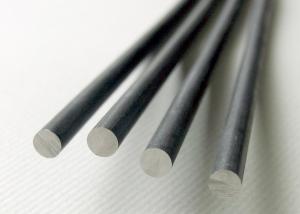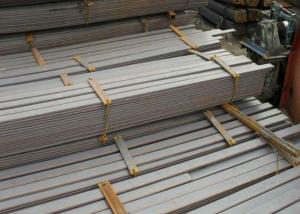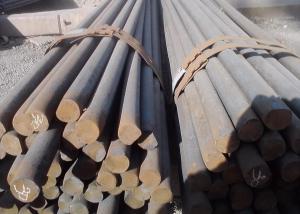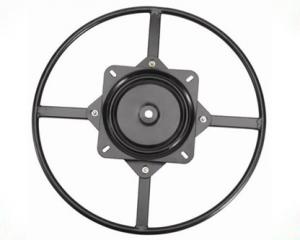Hot rolled Steel Wire Rod in coils Q195 High Speed Wire Rod
- Loading Port:
- Tianjin
- Payment Terms:
- TT OR LC
- Min Order Qty:
- 10 m.t.
- Supply Capability:
- 10000 m.t./month
OKorder Service Pledge
OKorder Financial Service
You Might Also Like
Specification
Hot rolled Steel Wire Rod in coils Q195 High Speed Wire Rod
Details of Hot rolled Steel Wire Rod in coils Q195 High Speed Wire Rod
| Steel Grade | Q195-Q235,Q235,SAE 1008-1018 Hot Rolled Steel Wire Rod |
| Diameter | 5.5, 6.5, 7,8, 9,10, 12,14mm.etc. |
| Coil weight | 2m.t. |
| Application | drawing, construction materials, machinery parts,construction for Houses, Bridges, Roads,Packing |
| Deliver Time | 25-30 days after receipt of L/C or deposit by T/T |
| Packing | In coils, loading in container or by bulk vessel |
| Payment terms | 1).100% irrevocable L/C at sight. |
| 2).30% T/T prepaid and the balance against the copy of B/L. | |
| 3).30% T/T prepaid and the balance against L/C |
| Chemical Composition(%) | ||||||
| C | Mn | Si | S | P | Cr | |
| SAE1006B | 0.03~O.07 | ≤0.32 | ≤0.30 | ≤0.045 | ≤0.040 | 0.3-0.35 |
| Mechanical properties | ||||||
| Yield strength(N/mm2) | Tensile strength(N/mm2) | Elongation(%) | ||||
| 250-280 | 350-380 | ≥32 | ||||
| Grade | Chemical Composition(%) | |||||
| C | Mn | Si | S | P | Cr | |
| SAE1008B | 0.10max | 0.3~O.50 | 0.15max | 0.050max | 0.040 max | 0.3-0.35 |
| Mechanical properties | ||||||
| Yield strength(N/mm2) | Tensile strength(N/mm2) | Elongation(%) | ||||
| ≥195 | 315-430 | ≥30 | ||||
Supplier of the Hot rolled Steel Wire Rod in coils Q195 High Speed Wire Rod
CNBM International Corporation is the most import and export platform of CNBM group(China National Building Material Group Corporation) ,which is a state-owned enterprise, ranked in 270th of Fortune Global 500 in 2015.
With its advantages, CNBM International are mainly concentrate on Cement, Glass, Iron and Steel, Ceramics industries and devotes herself for supplying high quality series of refractories as well as technical consultancies and logistics solution.
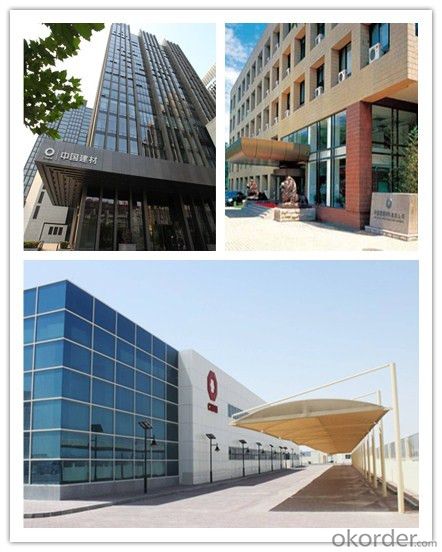

Delivery of the Hot rolled Steel Wire Rod in coils Q195 High Speed Wire Rod
Packaging Detail | Sea worthy packing /as per customer's packing instruction |
Delivery Detail | 15 ~ 40 days after receiving the deposit |
Products Show
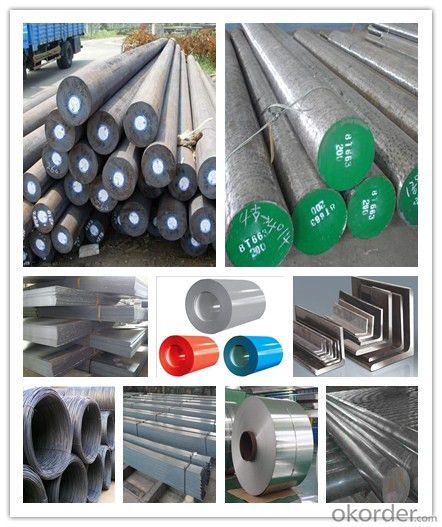
FAQ:
Are you a trading company or manufacturer? | Manufacturer |
What’s the MOQ? | 3 metric ton |
What’s your delivery time? | 15-35 days after downpayment received |
Do you Accept OEM service? | Yes |
what’s your delivery terms? | FOB/CFR/CIF |
What's the Payment Terms? | 30% as deposit,70% before shipment by T/T |
Western Union acceptable for small amount. | |
L/C acceptable for large amount. | |
Scrow ,Paybal,Alipay are also ok | |
Why choose us? | Chose happens because of quality, then price, We can give you both. Additionally, we can also offer professional products inquiry, products knowledge train (for agents), smooth goods delivery, excellent customer solution proposals. |
What's your available port of Shipment? | Main Port, China |
What’s your featured services? | Our service formula: good quality+ good price+ good service=customer's trust
|
Where are your Market? | Covering more than 160 countries in the world |
- Q: How does special steel perform in cryogenic creep resistance?
- Special steel is known for its exceptional performance in cryogenic creep resistance. Cryogenic creep refers to the deformation that occurs in materials under constant stress at extremely low temperatures. Special steel, due to its unique composition and manufacturing processes, exhibits superior resistance to this type of deformation compared to other materials. The low temperature environment encountered in cryogenic applications can cause conventional materials to lose their strength and become more susceptible to creep deformation. However, special steel is specifically designed to withstand these challenging conditions. Its composition typically includes a higher proportion of alloying elements such as nickel, chromium, and molybdenum, which enhance its mechanical properties and improve its resistance to creep at cryogenic temperatures. Furthermore, special steel undergoes rigorous heat treatment and processing techniques to optimize its microstructure and strengthen its grain boundaries. This results in a material with improved strength, toughness, and resistance to creep deformation, even at extremely low temperatures. The exceptional performance of special steel in cryogenic creep resistance makes it highly suitable for applications that involve storage, transportation, or processing of materials at cryogenic temperatures. Industries such as aerospace, energy, and scientific research heavily rely on special steel for the construction of cryogenic storage tanks, superconducting magnets, and cryogenic valves, among others. In conclusion, special steel exhibits remarkable performance in cryogenic creep resistance due to its unique composition, heat treatment, and processing techniques. Its ability to maintain its mechanical properties and resist deformation at extremely low temperatures makes it an ideal choice for various cryogenic applications.
- Q: What are the different methods of surface thermal spraying for special steel?
- There are several different methods of surface thermal spraying that can be used for special steel. These methods include: 1. Flame spraying: In this method, a flame or oxy-fuel source is used to melt the coating material, which is then sprayed onto the surface of the special steel. This method is commonly used for applying coatings such as zinc, aluminum, or their alloys. 2. Arc spraying: Arc spraying involves using an electric arc to melt the coating material, which is then propelled onto the surface of the special steel using compressed air. This method is often used for applying coatings such as stainless steel, nickel alloys, or copper. 3. Plasma spraying: Plasma spraying utilizes a plasma torch to heat and melt the coating material, which is then propelled onto the surface of the special steel. This method is particularly effective for applying coatings such as ceramic or metallic materials with high melting points. 4. High-velocity oxy-fuel (HVOF) spraying: HVOF spraying involves using a high-pressure combustion process to propel the coating material onto the surface of the special steel. This method produces coatings with high bond strength and density, making it suitable for applications requiring wear resistance or corrosion protection. 5. Detonation spraying: Detonation spraying utilizes a controlled detonation process to accelerate the coating material onto the surface of the special steel. This method is often used for applying coatings such as tungsten carbide or other hard materials, providing excellent wear resistance. Each of these methods of surface thermal spraying offers distinct advantages and is selected based on the specific requirements of the special steel application, including the desired coating material, thickness, and performance characteristics.
- Q: Can special steel be used in the production of springs for watches?
- Yes, special steel can be used in the production of springs for watches. Special steel, commonly known as spring steel, possesses high elasticity and strength, making it ideal for creating precision springs that are essential for the functioning of watches. It provides the necessary resilience and durability required for the accurate and reliable timekeeping of watches.
- Q: How is corrosion-resistant alloy steel used in the production of chemical processing equipment?
- Corrosion-resistant alloy steel is widely used in the production of chemical processing equipment due to its ability to withstand harsh chemical environments. It is used to construct various components such as pipes, tanks, valves, and heat exchangers, providing excellent resistance to corrosion and chemical attack. This ensures the integrity and longevity of the equipment, preventing leaks, contamination, and potential hazards. Additionally, corrosion-resistant alloy steel offers high strength and durability, making it suitable for handling aggressive chemicals and maintaining operational efficiency in chemical processing plants.
- Q: How does special steel contribute to the food processing industry?
- Special steel contributes to the food processing industry by providing high-quality and durable materials for the production of equipment and machinery. The unique properties of special steel, such as corrosion resistance, heat resistance, and hygiene, ensure that the food processing industry can maintain strict standards of cleanliness and efficiency. This type of steel is used in various applications, including cutting, grinding, and packaging, ultimately enhancing the safety, productivity, and longevity of food processing operations.
- Q: How does special steel perform in defense applications?
- Special steel is highly valued in defense applications due to its exceptional properties and performance. Firstly, special steel offers superior strength and toughness, making it highly resistant to impact and penetration. This strength is crucial in defense applications, as it provides protection against projectiles, explosives, and other threats. Additionally, special steel exhibits excellent hardness and wear resistance, making it ideal for applications such as armor plates, vehicle components, and protective gear. Its hardness enables it to withstand high-velocity impacts, while its wear resistance ensures durability and longevity even in extreme conditions. Moreover, special steel possesses excellent corrosion resistance, which is crucial in defense applications where exposure to harsh environments, saltwater, and chemicals is common. This corrosion resistance helps to maintain the structural integrity and performance of defense equipment, even in challenging conditions. Furthermore, special steel can be tailored to meet specific requirements, allowing for the customization of defense applications. By adjusting the alloy composition and heat treatment processes, special steel can be optimized for different purposes, such as ballistic armor, submarine hulls, or aircraft components. Overall, special steel's exceptional strength, toughness, hardness, wear resistance, corrosion resistance, and customizability make it an invaluable material in defense applications. It provides the necessary protection, durability, and reliability required to safeguard military personnel, vehicles, and equipment in various challenging scenarios.
- Q: What are the requirements for special steel used in battery technology?
- To ensure optimal performance and safety, special steel utilized in battery technology must fulfill several requirements. First and foremost, it is imperative that the steel exhibits high corrosion resistance. This is crucial due to the presence of corrosive electrolytes within batteries that can gradually deteriorate the steel. Special steel must possess exceptional resistance to corrosion in order to prevent any chemical reactions that may compromise the battery's integrity and lifespan. Additionally, the steel must possess good mechanical strength to withstand the internal pressures and external forces that batteries encounter during operation and handling. It should be capable of resisting deformation and maintaining its structural integrity, even under high-stress conditions. Furthermore, it is desirable for the special steel to have high thermal conductivity. This is essential for efficient heat dissipation, as overheating can diminish battery performance and potentially lead to safety hazards. Steel with excellent thermal conductivity facilitates effective heat transfer, ensuring that the battery can function within safe temperature limits. Moreover, the steel should exhibit low electrical resistivity to minimize energy losses resulting from electrical resistance. This guarantees efficient energy transfer within the battery and reduces power dissipation, ultimately enhancing overall battery efficiency. In addition, compatibility with other battery materials, such as electrodes, electrolytes, and separators, is crucial. Ensuring compatibility prevents any chemical reactions or detrimental interactions that may jeopardize the battery's performance or lifespan. Finally, in line with the growing emphasis on environmental sustainability, it is increasingly important for special steel used in batteries to be produced using environmentally friendly methods. This entails minimizing the carbon footprint and reducing the consumption of scarce resources. To summarize, special steel utilized in battery technology must possess high corrosion resistance, mechanical strength, thermal conductivity, low electrical resistivity, compatibility with other battery materials, and environmental sustainability. These attributes are necessary to ensure optimal performance and safety in batteries.
- Q: How does special steel perform in terms of weldability?
- Special steel generally has good weldability due to its composition and specific manufacturing processes. It can be easily joined or welded to other metals through various welding techniques. The high carbon content and alloying elements in special steel provide good heat resistance and prevent cracking during welding. Additionally, special steel often undergoes specific heat treatments to optimize its weldability, making it a preferred choice in industries that require strong and reliable welded structures.
- Q: Can special steel be used in the production of surgical instruments?
- Yes, special steel can be used in the production of surgical instruments. Special steel alloys, such as stainless steel, are commonly used due to their desirable properties like corrosion resistance, strength, and their ability to be easily sterilized. These characteristics make special steel an ideal material for surgical instruments that require high precision and durability.
- Q: What are the different mechanical defects in special steel?
- There are several mechanical defects that can occur in special steel, which can compromise its overall strength and performance. Some of the most common defects include: 1. Inclusions: Inclusions are foreign particles or impurities that are present in the steel. These can include oxides, sulfides, or other non-metallic materials. Inclusions can weaken the steel and reduce its ductility, making it more prone to cracking or failure. 2. Segregation: Segregation refers to the uneven distribution of alloying elements within the steel. This can lead to variations in hardness, strength, and other mechanical properties across the material. Segregation can create localized areas of weakness, increasing the likelihood of failure under stress. 3. Cracks: Cracks can occur in special steel due to a variety of factors, such as improper cooling, excessive heat, or high levels of stress. Cracks can significantly reduce the structural integrity of the steel and may propagate over time, leading to catastrophic failure. 4. Laminations: Laminations are thin layers or sheets of material that are formed during the manufacturing process. They can occur due to improper rolling or forging, or the presence of inclusions. Laminations can weaken the steel and lead to premature failure under load. 5. Decarburization: Decarburization is the loss of carbon from the surface of the steel, typically due to exposure to high temperatures or oxidation. This can result in a layer of softer, lower carbon steel on the surface, reducing the overall hardness and strength of the material. 6. Grain growth: Grain growth occurs when the individual crystals within the steel (grains) grow larger over time. This can happen due to high temperatures, prolonged exposure to stress, or improper heat treatment. Grain growth can reduce the strength and toughness of the steel, making it more prone to deformation or fracture. It is important to note that these mechanical defects can vary in severity and are often influenced by factors such as the manufacturing process, quality control measures, and the specific composition of the special steel. Regular inspection, testing, and adherence to proper handling and processing techniques are essential to minimize these defects and ensure the desired mechanical properties in special steel.
Send your message to us
Hot rolled Steel Wire Rod in coils Q195 High Speed Wire Rod
- Loading Port:
- Tianjin
- Payment Terms:
- TT OR LC
- Min Order Qty:
- 10 m.t.
- Supply Capability:
- 10000 m.t./month
OKorder Service Pledge
OKorder Financial Service
Similar products
Hot products
Hot Searches
Related keywords








